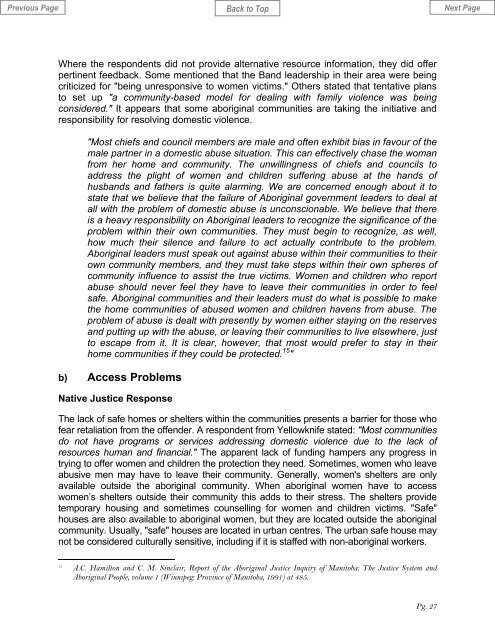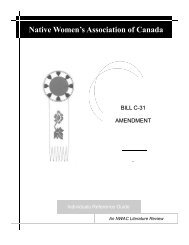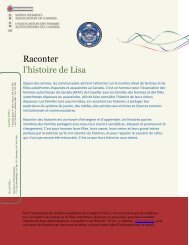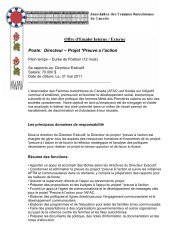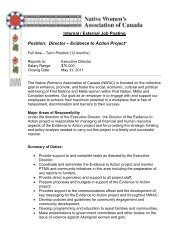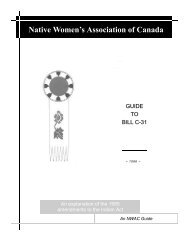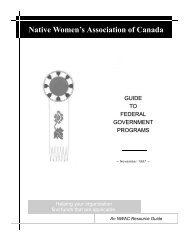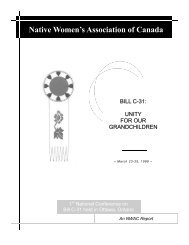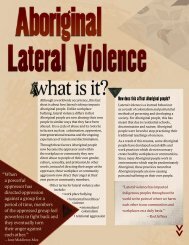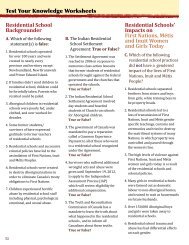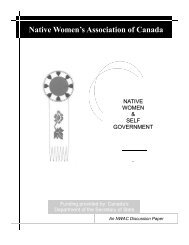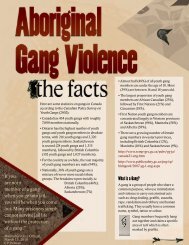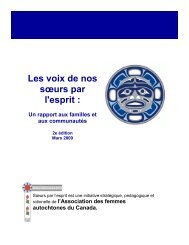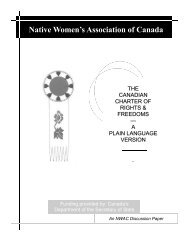POLICE CHARGING POLICIES & DOMESTIC VIOLENCE - Native ...
POLICE CHARGING POLICIES & DOMESTIC VIOLENCE - Native ...
POLICE CHARGING POLICIES & DOMESTIC VIOLENCE - Native ...
- No tags were found...
You also want an ePaper? Increase the reach of your titles
YUMPU automatically turns print PDFs into web optimized ePapers that Google loves.
Where the respondents did not provide alternative resource information, they did offerpertinent feedback. Some mentioned that the Band leadership in their area were beingcriticized for "being unresponsive to women victims." Others stated that tentative plansto set up "a community-based model for dealing with family violence was beingconsidered." It appears that some aboriginal communities are taking the initiative andresponsibility for resolving domestic violence."Most chiefs and council members are male and often exhibit bias in favour of themale partner in a domestic abuse situation. This can effectively chase the womanfrom her home and community. The unwillingness of chiefs and councils toaddress the plight of women and children suffering abuse at the hands ofhusbands and fathers is quite alarming. We are concerned enough about it tostate that we believe that the failure of Aboriginal government leaders to deal atall with the problem of domestic abuse is unconscionable. We believe that thereis a heavy responsibility on Aboriginal leaders to recognize the significance of theproblem within their own communities. They must begin to recognize, as well,how much their silence and failure to act actually contribute to the problem.Aboriginal leaders must speak out against abuse within their communities to theirown community members, and they must take steps within their own spheres ofcommunity influence to assist the true victims. Women and children who reportabuse should never feel they have to leave their communities in order to feelsafe. Aboriginal communities and their leaders must do what is possible to makethe home communities of abused women and children havens from abuse. Theproblem of abuse is dealt with presently by women either staying on the reservesand putting up with the abuse, or leaving their communities to live elsewhere, justto escape from it. It is clear, however, that most would prefer to stay in theirhome communities if they could be protected. 15 "b) Access Problems<strong>Native</strong> Justice ResponseThe lack of safe homes or shelters within the communities presents a barrier for those whofear retaliation from the offender. A respondent from Yellowknife stated: "Most communitiesdo not have programs or services addressing domestic violence due to the lack ofresources human and financial." The apparent lack of funding hampers any progress intrying to offer women and children the protection they need. Sometimes, women who leaveabusive men may have to leave their community. Generally, women's shelters are onlyavailable outside the aboriginal community. When aboriginal women have to accesswomen’s shelters outside their community this adds to their stress. The shelters providetemporary housing and sometimes counselling for women and children victims. "Safe"houses are also available to aboriginal women, but they are located outside the aboriginalcommunity. Usually, "safe" houses are located in urban centres. The urban safe house maynot be considered culturally sensitive, including if it is staffed with non-aboriginal workers.15A.C. Hamilton and C. M. Sinclair, Report of the Aboriginal Justice Inquiry of Manitoba: The Justice System andAboriginal People, volume 1 (Winnipeg: Province of Manitoba, 1991) at 485.Pg. 27


